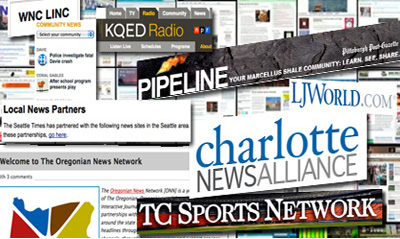
About the project:
In 2009, J-Lab launched the first five of what would turn out to be nine pilot projects in collaborative journalism in the United States. Eight newspapers and one public radio station agreed to try to partner with at least five local independent news start-ups in their communities for one year.
The projects resulted in seven geographic networks and two topic networks with astonishingly different models of collaboration. At its height, the nine hub newsrooms had grown their networks from 44 partners to 169; 146 partners were still participating as of October 2012.
Three years into the experiment five of the partners were still going strong. Two had very strong starts and made it to second base, but by the third year are greatly diminished. Two are inactive.
Success stories included The Seattle Times, The Charlotte Observer, the Pittsburgh Post-Gazette,The Oregonian in Portland and KQED Public Radio in San Francisco. The Miami Herald and TucsonCitizen.com launched bold and promising networks, but only a handful of partners remain active. The Asheville Citizen-Times and Lawrence Journal-World got off to strong starts but didn’t make a go of it.
J-Lab assembled the lessons learned in a full report, “Networked Journalism: What Works,” released in November, 2012.
2010
2009
- What are the attributes to look for in recruiting partners?
- What kinds of partners do, or don’t, want to work with a mainstream news organization?
- What kind of partner content is valuable enough for mainstream news outlets to give it an added voice or use it as a basis for enterprise reporting?
- What are the opportunities to share content?
- What other community sites asked to join the network?
- How do you maintain a sense of “ownership” among the community partners while also gelling the collaboration as a “network?”
- How do you measure success?






